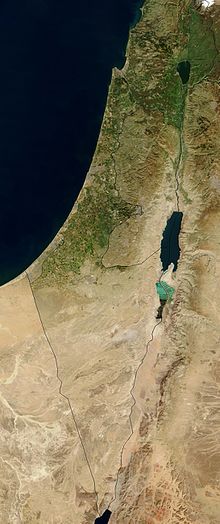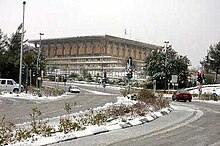Geography of Israel
Physical-political map of Israel |
The geography of the State of Israel is the description of the physical condition of the State of Israel .
overview
The State of Israel ( Hebrew : Medinat Jisra'el ) is located in Western Asia on the eastern shore of the Mediterranean . Its southern tip borders the Gulf of Aqaba of the Red Sea . Israel has four neighboring states: Lebanon in the north, Syria in the north-east, Jordan in the east and Egypt in the south-west . The national territory has an area of 22,380 km² excluding the occupied territories and extends from south to north over a length of about 470 km.
The south of the country is occupied by the Negev , an approximately 12,000 km² desert that extends to the port city of Eilat on the Red Sea. The north is divided into three areas: the mountainous region, the Jordan Valley and the coastal plain. The mountainous country is divided from north to south into Galilean, Samaritic and Judean mountainous country.
The fish-rich freshwater lake, the Sea of Galilee, has an area of 166 km² and is over 200 m below sea level. It is traversed by the Jordan , which flows into the Dead Sea, in a north-south direction. The river forms the border with Jordan . The part to the west of the river - the West Bank - has been occupied by Israel since 1967. The coastal plain has its central part in the fertile Sharon , which widens to about 40 km to the south. A hill country to the east called Schefelah leads to the Judean mountains. The largest city in the country and the capital is Jerusalem with around 933,200 inhabitants.
surface
Israel covers (in the armistice lines of 1949, the so-called " Green Line ") a total area of 20,991 km². With the Jerusalem Act 1980 and the annexation of the Golan Heights in 1981, Israel has an area of 22,380 km² from the Israeli perspective. Thereof:
- 3 ~ 6% forest
Since the 1950s, Israel began to plant forests . In total, more than 240 million trees have been planted to date. Today about 3% of Israel's area (213,000 hectares) is forested. Other estimates go up to 6%. - 20.1% arable land and fields
Around 20.1% of the land is used as arable land or fields, especially for growing melons , tomatoes , cucumbers , peppers , strawberries , kiwis , mangoes , avocados and citrus fruits . - 50% desert
About 50% of the country is covered by deserts, with the Negev desert being the largest. - Mountains
Only a small part of the country is located in the mountainous regions of the Hebron Mountains and the Judean and Galilean Mountains.
Limits
Israel has a common border with a total of four states, plus the border with the disputed Palestinian autonomous regions .
These are the limits to:
- Egypt 255 km,
- Jordan 240 km,
- Syria 80 km,
- the Lebanon also 80 km,
- as well as to the Gaza Strip and the West Bank with a length of around 50 km and around 320 km respectively.
Coastal plain
Israel has a coast to the Mediterranean with a length of around 275 km, including the Sharon plain , and a coast to the Red Sea with around 15 km. The only city on this coast is Eilat , the southernmost city in Israel.
Mountains
Israel is a rather flat country. The highest mountain is the Hermon with a height of 2814 m . South of the summit is the highest point in the areas controlled by Israel, at an altitude of 2224 m .
Other high mountains are:
- Meron 1208 m .
- Har Ramon 1035 m .
- Jerusalem Mount of Olives 835 m.
- Tabor 588 m.
- Carmel 546 m.
Waters
The 322 km long Jordan is the longest river in the country. It consists of the three source rivers in northern Israel: Dan , Hazbani and the Banyas source. After flowing through the Chula plain , the Jordan reaches the 165 km² Sea of Galilee. With a volume of 3 km³, the lake is Israel's most important water reservoir. The Jordan emerges again in the south of the lake and flows into the drainless and very salty Dead Sea . The 1020 km² Dead Sea is the lowest point on the earth's surface at −427 m. In the south of the Dead Sea, the rift valley continues in the Arava Depression (border with Jordan) to the Gulf of Aqaba . The Kishon drains the fertile Jezreel plain between the Galilean mountains in the north and the mountains Gilboa and Carmel in the south. The Jarkon in the Sharon plain with its tributary Ajalon , which comes from the Schefelah, flows into the Mediterranean in Tel Aviv-Jaffa .
caves
The longest salt cave in the world has been located under Mount Sodom on the Dead Sea since March 2019. The area was originally discovered in the 1980s. Israeli researchers have re-measured the 10-kilometer-long Malham Cave with international support. Salt caves arise when rainwater penetrates a salt deposit, the salt dissolves and can be transported away through underground channels. The dried up river bed remains as a cave. Geologically speaking, they are alive . Mount Sodom is eleven kilometers long and sits 170 meters below sea level on the southwest tip of the Dead Sea. Under a thin layer of stone, the mountain is made entirely of salt.
climate
Israel's climate ranges from temperate to tropical - with plenty of sunshine. Two characteristic seasons are predominant: the rainy season from November to May followed by a dry six-month summer.
Israel can be divided into four climate zones. The small country at the junction of three continents thus offers extreme weather conditions, ranging from occasional snowfalls in the mountains to extremely hot dry winds in the desert area. The rainy season from November to May brings a lot of rain to the north, while the south remains free of precipitation for most of the year.
Mediterranean climate: The coastal strip offers a warm and humid summer, in winter it usually rains abundantly. The coastal plain is very fertile and is used for agriculture. The Mediterranean is an attractive holiday destination for domestic and foreign tourists.
Steppe climate: In summer it is mostly dry and warm here. In winter it gets cold, snowfalls are rare but not uncommon. This zone is very hilly and extends from the Golan Heights with the 2800 meter high Hermon to the Galilean Mountains and the mountains of Judea and Samaria. It stretches from the Sea of Galilee via Jerusalem to the north of Beersheba . The Golan and the Sea of Galilee are the main sources of drinking water in the country. Sufficient rainfall during the rainy season is very important here.
Desert and extreme desert climates: At the Dead Sea, in the Negev desert all the way down to Eilat, it is hot all year round. While the northern area cools down pleasantly in winter, the south and the area directly on the Dead Sea remain hot and dry all year round. The temperatures sometimes reach 50 degrees Celsius. The Negev desert covers almost half the area of Israel, but only 8 percent of the population live here. There are many dry river beds, so-called wadis , which can briefly turn into torrential torrents. The south consists of bare and rugged rock formations and craters, such as the Machtesch Ramon , as well as plateaus strewn with rubble.
Israel's mild climate is characterized by a lot of sunshine; Rain only falls in the months of November to April . The total annual precipitation is 500–750 mm in the north and about 30 mm in the southern desert areas.
Flora and fauna
The location of Israel at the intersection of three continents is reflected in the rich diversity of its flora and fauna as well as in the different topography and different climatic conditions. More than 500 species of birds, around 100 species of mammals and 90 species of reptiles, as well as around 3000 species of plants, over 150 of which are exclusively native to Israel, can be found within the country's borders. There are around 150 nature reserves and 65 national parks covering a total of 1000 km², and several hundred more facilities are in the planning stage.
Islands
Israel has no islands in its territorial waters. The Israeli government is planning to build artificial islands in the Mediterranean and an island city in the Red Sea. These islands should be used as living space, military terrain or for airports.
Natural resources
Israel is dependent on imports for fossil fuels (crude oil, natural gas, coal). However, there are small amounts of petroleum , phosphates , potash and kaolin in the country . It is unknown whether Israel has precious metals and stones as additional mineral resources. However, large gold deposits are suspected. In the case of natural gas, there has been a shift in import dependency since four deposits were discovered off the Mediterranean coast. Since 2014, Israel has been producing natural gas from the “ Tamar ” gas field , which is around 90 kilometers from Haifa , which is then sent to the southern Israeli city of Ashdod for further processing .
literature
- An Empire in the Holy Land : Historical Geography of the British Administration in Palestine, 1917–1929, Gideon Biger , 1994, pp. 40–41.
- Mahler, Gregory S. Politics and Government in Israel: The Maturation of a Modern State . Rowman & Littlefield. Page 229.
Web links
- Geography & Nature in Israel (English)
- Geography about Israel (English)
Individual evidence
- ^ Israel at 65: A statistical glimpse. Israel Ministry of Foreign Affairs, April 1, 2013, accessed July 8, 2014 .
- ^ Longest salt cave in the world discovered in Israel. In: Israelnetz .de. March 28, 2019, accessed April 12, 2019 .
- ↑ http://www.ynetnews.com/articles/0,7340,L-4243546,00.html
- ↑ Raw materials of Israel on schatzwert.de
- ↑ Hans-Christian Rößler: Suddenly a gas exporter. , faz.net, May 20, 2014, accessed May 20, 2014.
- ↑ Israel is now a natural gas nation on www.taz.de 2014




